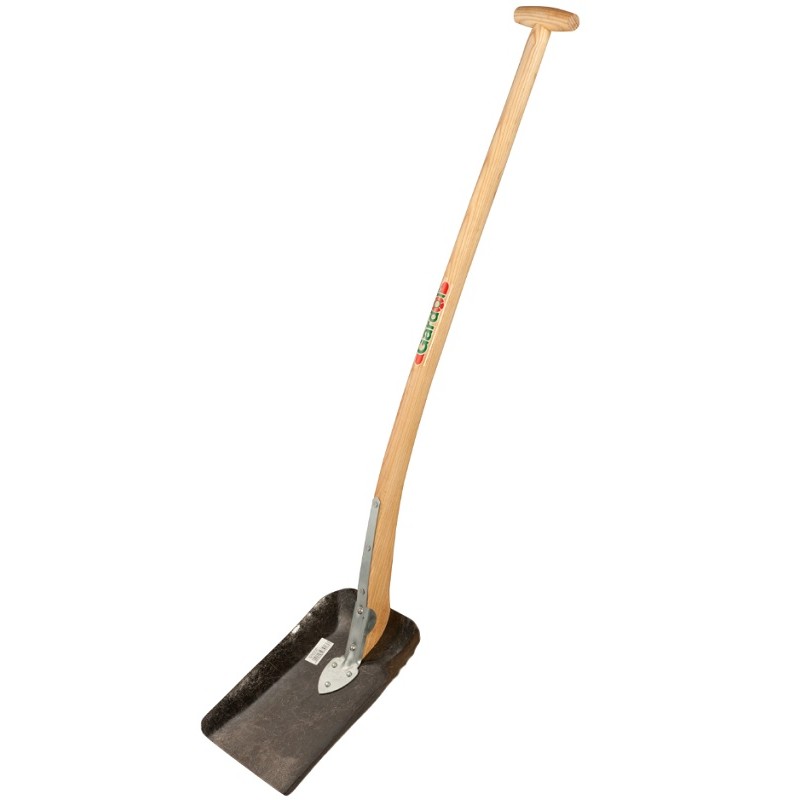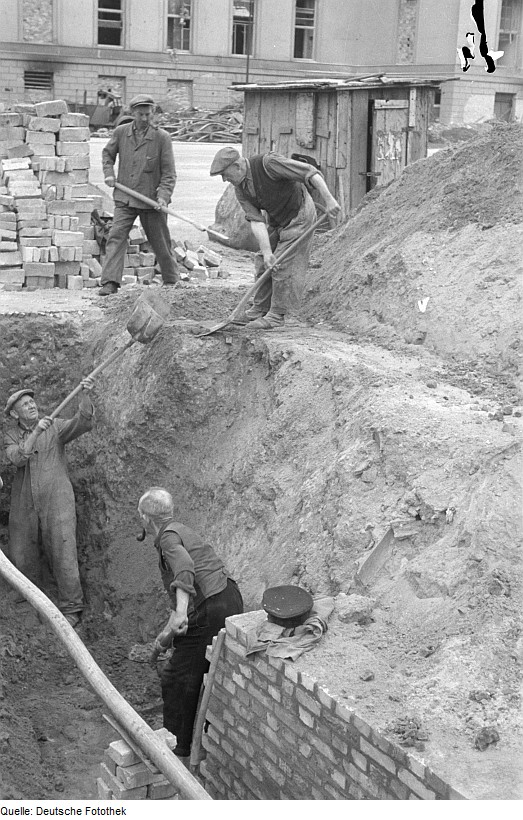Shovel on:
[Wikipedia]
[Google]
[Amazon]
 A shovel is a
A shovel is a
 In the
In the
The later invention of purpose-built shovels was a ground-breaking development. Manual shoveling, often in combination with picking, was the chief means of excavation in construction until
pp. 64–75
Taylor, with his focus on
 A shovel is a
A shovel is a tool
A tool is an Physical object, object that can extend an individual's ability to modify features of the surrounding environment or help them accomplish a particular task. Although many Tool use by animals, animals use simple tools, only human bei ...
used for digging, lifting, and moving bulk materials, such as soil
Soil, also commonly referred to as earth, is a mixture of organic matter, minerals, gases, water, and organisms that together support the life of plants and soil organisms. Some scientific definitions distinguish dirt from ''soil'' by re ...
, coal
Coal is a combustible black or brownish-black sedimentary rock, formed as rock strata called coal seams. Coal is mostly carbon with variable amounts of other Chemical element, elements, chiefly hydrogen, sulfur, oxygen, and nitrogen.
Coal i ...
, gravel, snow
Snow consists of individual ice crystals that grow while suspended in the atmosphere—usually within clouds—and then fall, accumulating on the ground where they undergo further changes.
It consists of frozen crystalline water througho ...
, sand, or ore. Most shovels are hand tools consisting of a broad blade
A blade is the Sharpness (cutting), sharp, cutting portion of a tool, weapon, or machine, specifically designed to puncture, chop, slice, or scrape surfaces or materials. Blades are typically made from materials that are harder than those they a ...
fixed to a medium-length handle
A handle is a part of, or an attachment to, an object that allows it to be grasped and object manipulation, manipulated by hand. The design of each type of handle involves substantial ergonomics, ergonomic issues, even where these are dealt wi ...
. Shovel blades are usually made of sheet steel or hard plastics and are very strong. Shovel handles are usually made of wood (especially specific varieties such as ash or maple) or glass-reinforced plastic
Fiberglass (American English) or fibreglass ( Commonwealth English) is a common type of fiber-reinforced plastic using glass fiber. The fibers may be randomly arranged, flattened into a sheet called a chopped strand mat, or woven into glass c ...
(fiberglass).
Hand shovel blades made of sheet steel usually have a folded seam or hem at the back to make a socket for the handle. This fold also commonly provides extra rigidity to the blade. The handles are usually riveted in place. A T-piece is commonly fitted to the end of the handle to aid grip and control where the shovel is designed for moving soil and heavy materials. These designs can all be easily mass-produced.
The term ''shovel'' also applies to larger excavating machines called power shovel
A power shovel, also known as a motor shovel, stripping shovel, front shovel, mining shovel or rope shovel, is a bucket-equipped machine usually powered by steam, diesel fuel, gasoline or electricity and used for digging and loading earth or frag ...
s, which serve the same purpose—digging, lifting, and moving material. Although such modern power shovels as front-end loaders and excavator
Excavators are heavy equipment (construction), heavy construction equipment primarily consisting of a backhoe, boom, dipper (or stick), Bucket (machine part), bucket, and cab on a rotating platform known as the "house".
The modern excavator's ...
s (including tractors that feature a loading bucket on one end and a backhoe for digging and placing material on the other) descend from steam shovels and perform similar work, they are not classified as shovels.
Hand shovels have been adapted for many different tasks and environments. They can be optimized for a single task or designed as cross-over or compromise multitaskers. They are commonly used in agriculture
Agriculture encompasses crop and livestock production, aquaculture, and forestry for food and non-food products. Agriculture was a key factor in the rise of sedentary human civilization, whereby farming of domesticated species created ...
.
It is also utilized in archaeology
Archaeology or archeology is the study of human activity through the recovery and analysis of material culture. The archaeological record consists of Artifact (archaeology), artifacts, architecture, biofact (archaeology), biofacts or ecofacts, ...
to locate and excavate all subsurface dirt.
History
 In the
In the Neolithic
The Neolithic or New Stone Age (from Ancient Greek, Greek 'new' and 'stone') is an archaeological period, the final division of the Stone Age in Mesopotamia, Asia, Europe and Africa (c. 10,000 BCE to c. 2,000 BCE). It saw the Neolithic Revo ...
age and earlier, a large animal's scapula (shoulder blade) was often used as a crude shovel or spade. Shovels at this time were often used for farming.''Concise Oxford Dictionary of Archaeology'', p. 304The later invention of purpose-built shovels was a ground-breaking development. Manual shoveling, often in combination with picking, was the chief means of excavation in construction until
mechanization
Mechanization (or mechanisation) is the process of changing from working largely or exclusively by hand or with animals to doing that work with machinery. In an early engineering text, a machine is defined as follows:
In every fields, mechan ...
via steam shovels and later hydraulic equipment (excavator
Excavators are heavy equipment (construction), heavy construction equipment primarily consisting of a backhoe, boom, dipper (or stick), Bucket (machine part), bucket, and cab on a rotating platform known as the "house".
The modern excavator's ...
s such as backhoes and loaders) gradually replaced most manual shoveling. The same is also true of the history of mining
Mining is the Resource extraction, extraction of valuable geological materials and minerals from the surface of the Earth. Mining is required to obtain most materials that cannot be grown through agriculture, agricultural processes, or feasib ...
and quarry
A quarry is a type of open-pit mining, open-pit mine in which dimension stone, rock (geology), rock, construction aggregate, riprap, sand, gravel, or slate is excavated from the ground. The operation of quarries is regulated in some juri ...
ing and of bulk materials handling in industries such as steelmaking and stevedoring. Railroad cars and cargo holds containing ore, coal, gravel, sand, or grain
A grain is a small, hard, dry fruit (caryopsis) – with or without an attached husk, hull layer – harvested for human or animal consumption. A grain crop is a grain-producing plant. The two main types of commercial grain crops are cereals and ...
s were often loaded and unloaded this way. These industries did not always rely ''exclusively'' on such work, but such work was a ubiquitous part of them. Until the 1950s, manual shoveling employed large numbers of workers. Groups of workers called 'labor gangs' were assigned to whatever digging or bulk materials handling was needed in any given week, and dozens or hundreds of workers with hand shovels would do the kind of rapid excavating or materials handling that today is usually accomplished with powered excavators and loaders operated by a few skilled operators. Thus the cost of labor, even when each individual worker was poorly paid, was a tremendous expense of operations. Productivity of the business was tied mostly to labor productivity. It still often is even today; but in the past it was even more so. In industrial and commercial materials handling, hand shoveling was later replaced with loaders and backhoes.
Given the central importance and cost of manual labour in industry in the late 19th and early 20th centuries, the "science of shoveling" was something of great interest to developers of scientific management such as Frederick Winslow Taylor.pp. 64–75
Taylor, with his focus on
time and motion study
A time and motion study (or time–motion study) is a business efficiency technique combining the ''time study'' work of Frederick Winslow Taylor with the ''motion study'' work of Frank and Lillian Gilbreth (the same couple as is best known t ...
, took an interest in differentiating the many motions of manual labor to a far greater degree than others tended to. Managers might not care to analyze it (possibly motivated by the assumption that manual labor is intellectually simple work), and workers might not care to analyze it in any way that encouraged management to take away the prerogative
In law, a prerogative is an exclusive right bestowed by a government or State (polity), state and invested in an individual or group, the content of which is separate from the body of rights enjoyed under the general law. It was a common facet of ...
in craft work for the craftsman to decide the details of his methods. Taylor realized that failing to analyze shoveling practice represented a missed opportunity to discover or synthesize best practice
A best practice is a method or technique that has been generally accepted as superior to alternatives because it tends to produce superior results. Best practices are used to achieve quality as an alternative to mandatory standards. Best practice ...
s for shoveling, which could achieve highest productivity (value for dollar spent). It was Taylor and colleagues in the 1890s through 1910s that greatly expanded the existing idea of varied shovel designs with different-sized scoops, one for each material, based on the material's density. Under scientific management, it was no longer acceptable to use the same shovel for shoveling brown coal one day and gravel the next. Taylor said the increased worker productivity, and corresponding savings in wages paid, would offset the capital cost of maintaining two shovels.
During the Second Industrial Revolution
The Second Industrial Revolution, also known as the Technological Revolution, was a phase of rapid Discovery (observation), scientific discovery, standardisation, mass production and industrialisation from the late 19th century into the early ...
around 1900, heavy equipment such as crawler excavators became available.
Shovels known as entrenching tools were made by the British in 1908. They were used by the Germans in World War I and World War II.
Types
See also
* Entrenching tool * DustpanCitations
General bibliography
*External links
* {{Authority control Gardening tools